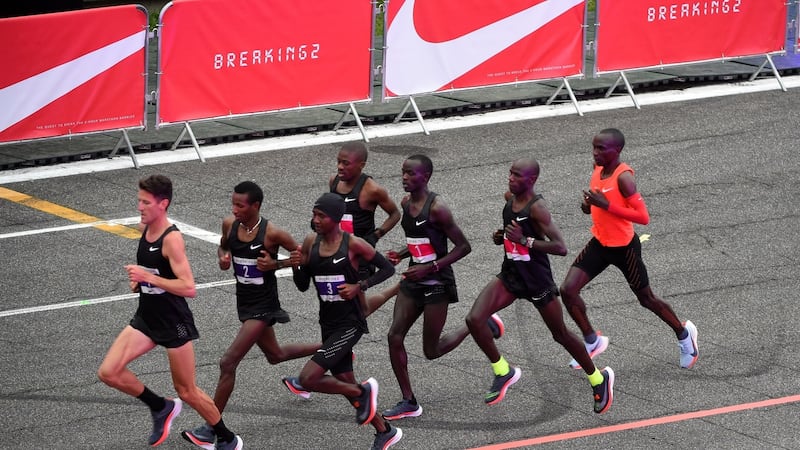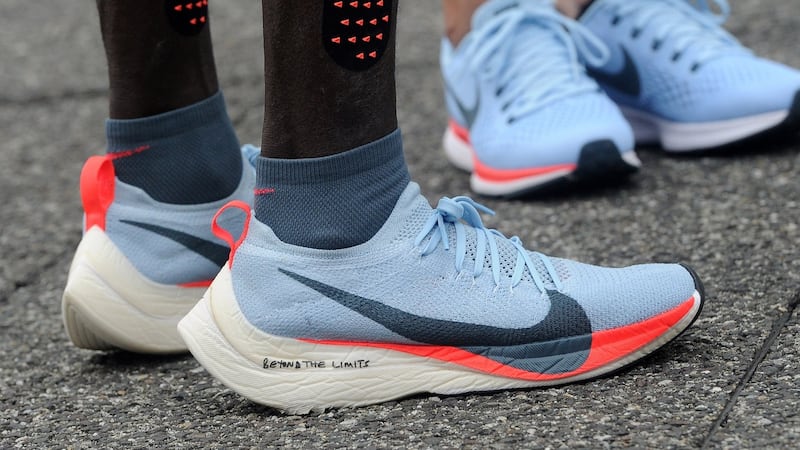The audacious yet controversial attempt to shatter the two-hour barrier for the marathon for the first time ended in glorious failure on Saturday as Eliud Kipchoge came within 26 seconds of achieving a feat many thought was impossible.
The 32-year-old Kipchoge, the Olympic marathon champion, finished in an astonishing 2:00.25 – more than two and a half minutes faster than the official world record of 2:02:57 set by Dennis Kimetto in 2014. However it will not count as an official record because Kipchoge was helped by a phalanx of 30 elite pacers, who subbed in and out of the attempt at the Monza formula one track in Italy, which is against the official rules of the athletics governing body, the International Association of Athletics Federations (IAAF).
Afterwards Kipchoge, who had been on course to go under two hours after about 18 miles, said he was happy to have come so close to making history.
“Thanks to all the pacers, to help me to go through this challenge,” he said.
“I hope to do it next time, but I am happy to have run a 2:00.25 marathon. My mind was fully on [the goal of]two hours but this journey has been good.
“It has been hard. It has taken seven good months of preparation and dedication, but I am happy to have done that time. It is history.”
It was still dark when Kipchoge – along with Zersenay Tadese, the half-marathon world-record holder, and Lelisa Desisa, a double Boston Marathon winner – stepped on to the track shortly before 5.45am local time on Saturday morning.
Going under two hours meant they would have to run each mile in an average of four minutes and 34 seconds – seven seconds a mile quicker than Kimetto managed in Berlin. Most sports scientists had assumed such speeds were impossible. But the sportswear company Nike had spent two years and invested millions to ensure this would be the fastest marathon in history. Now it was all down to the next two hours.
That this was no ordinary attempt was obvious from the start as the three athletes were immediately joined by six pacers who adopted an arrowhead formation behind a Tesla car with a giant clock timer on it. Studies in Nike’s wind tunnel had apparently shown that this formation would help them “draft” better, saving energy. However, running so close to the car would have provided even more substantial assistance.

That, however, wasn’t the only edge. The temperature was around 10 degrees, just about perfect for marathon running. The flat Monza course had far fewer bends than big city marathon courses such as London and New York, meaning that the athletes weren’t having to occasionally check their stride going around corners.
By far the biggest advantage was technology, in the form of Nike’s controversial Zoom Vaporfly Elite shoes. The soles of the trainers have a special curved plate that allows runners to “roll through” instead of bending toes and losing energy. This, some believe, should be illegal, because it gives athletes too much of an advantage. According to Nike, it boosts running economy by four per cent compared with their next best marathon shoe.

Even so, this was a massive undertaking. And while the athletes were on course after the first 15 kilometres, going through in 42:34 – which put them on 1:59.48 pace – Desisa was already starting to struggle and soon fell back. Just before halfway, Tadese found he couldn’t handle the pace either. Even with optimal conditions, pacers and shoes, two of the three athletes weren’t able to make it to halfway at their personal best half-marathon pace.
Now it was all down to Kipchoge. The Kenyan was reportedly paid about $1m (£770,000) to skip the London Marathon and commit himself to the attempt, with another $1m to come if he could run under two hours. Yet that didn’t appear to be on his mind. Deep into the second half of the race he still looked so easy and graceful, even smiling on occasions. Eventually the pace told on him, though. At 30km he was one second off the pace. After 35km it was five seconds. As a young athlete he had been fast enough to run a 3:50 mile, and in the final stages he tried to push again. But there was simply nothing left as he finished 26 seconds down. Tadese, meanwhile, came home in 2:06.51, with Desisa further back in 2:14:10.
Having got so close, the obvious temptation will be for Nike – or a rival company – to try and break the two-hour mark again. However, Matt Nurse, vice-president of the Nike Sport Research Lab, said that wasn’t necessarily a given.
“This is one particular endeavour where we have learned an awful lot about running and performance running, but another attempt is probably not what some other people want to do,” he said.
“We are already discussing other moonshots, perhaps related to female athletes. It’s not one and done, it just may take a different form next time.”
(Guardian service)



















